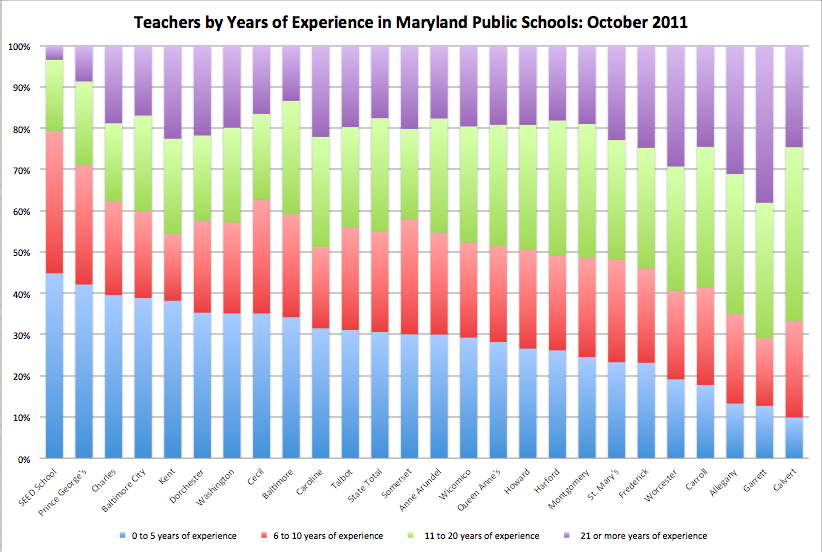
Teacher experience levels can vary dramatically state-to-state, but experience levels vary even more within states.
To show what this looks like, I’ve analyzed a dataset from the state of Maryland showing how experience levels vary by district. Data collected in the fall of 2011 found that, on average, 31% of all Maryland public school teachers had zero to five years of teaching experience. Another 24% had six to ten years of experience, 28% had 11 to 20 years, and only 18% had been in the classroom more than 20 years.
Some district workforces look very different from the state average, however. In Prince George’s County, for example, 42% of teachers had been working less than six years, with numbers in Charles County and Baltimore City County hovering near 40%. At the SEED school, a tuition-free public boarding school founded in 2008, nearly half its instructional staff was relatively new to the profession.
Other counties had much more experienced workforces. In Calvert County, for example, just 10% of teachers had five or fewer years of experience, and more than 60 percent of its teachers had 20 or more years of experience. Calvert County, a growing exurb south of Washington, D.C., has a median household income of $87,449, placing it amongst the top 20 wealthiest U.S. counties. Calvert joins Garrett, Allegany, Carroll, Worcester, Frederick, St. Mary’s, Montgomery and Harford, all districts where 50% or more of their teacher workforce has at least 11 years of experience.
These numbers reflect the range of challenges different districts face. Counties like Prince George’s, Charles, and Baltimore City employ much more mobile workforces, and thus spend more time and resources recruiting and training new teachers than Allegany, Garrett, and Calvert counties. Similarly, pension plans play out very differently amongst these two types of districts. Those with a more stable workforce are likely to reap larger benefits from the pension system, while districts with greater teacher turnover are likely to subsidize the pensions of everyone else.
A district’s teacher experience breakdown can reveal information about wide-reaching disparities, whether they be teacher turnover, resource allotment, or pension savings. Years of experience continues to persist as a key variable in teacher pension formulas, as well as salary negotiations. A revolving door of short- term teachers in some districts can end up padding the retirement benefits of others.
